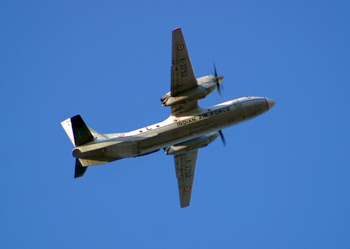INDIAN ARMED FORCES CHIEFS ON
OUR RELENTLESS AND FOCUSED PUBLISHING EFFORTS

SP Guide Publications puts forth a well compiled articulation of issues, pursuits and accomplishments of the Indian Army, over the years

I am confident that SP Guide Publications would continue to inform, inspire and influence.

My compliments to SP Guide Publications for informative and credible reportage on contemporary aerospace issues over the past six decades.
Missing An-32 - IAF medium lift aircraft
 |
By Lt. General P.C. Katoch (Retd) Former Director General of Information Systems, Indian Army |

Tragedy struck on July 22 when an IAF An-32 on routine sortie from IAF Station Tambaram to Port Blair went missing. The aircraft had 29 personnel onboard; six-member IAF crew including two pilots, two Army personnel, eight civilians from the Naval Armament Depot at Vizag, five IAF non-combatants, four airmen, one Defence Security Corps soldier and a sailor each from Navy and Coast Guard. Massive search and rescue operations were launched to locate the aircraft which included P8i long range maritime patrol aircraft, C-130J Super Hercules, Dornier aircraft and over a dozen ships. ISRO put off its scramjet propulsion mission from Sriharikota while the IAF requested ISRO help locating the missing aircraft. India has reportedly sought help from the US to assist in the ongoing search. It would need a miracle to locate the missing aircraft considering the Malaysian airliner MH 170 has not yet been located despite months of international efforts. "Request weather deviation to the right", were the last words of the pilot heard by the ATC, after which the aircraft took a right turn to avoid turbulence but then for some reason took a sharp left turn with rapid loss of height from its flying altitude of 23,000 feet. What exactly happened and why none of the pilots could give a ‘May Day’ call would only be known when the black box and the CVR are recovered. However, the fact that pilots could not give an emergency call indicates something sudden that prevented them doing so. The An-32 can carry 60 passengers or 42 paratroopers with full battle loads. This aircraft had only 29 personnel on board. Whether the cargo included munitions is not known. As per an IAF veteran, the An-32 due to its dynamic instability is difficult to fly by hand and is mostly flown on auto pilot in cruise conditions. At the same time the overall flight safety record of the An-32 has been reportedly good despite some accidents in the past. In one incident, one IAF An-32 vanished over the Arabian Sea while being flown in from Russia in a group. In March 1999, an IAF An-32 crashed close to IGI Airport killing all 21 onboard, reportedly also having taken a sharp turn.
The IAF holds over a hundred An-32 aircraft which commenced induction into the IAF in 1984. Not many know that while these aircraft were purchased from Russia for paradropping personnel into combat, no country in the world including Russia uses this aircraft for paradropping personnel. In fact, post the trials conducted in India then Commander of Parachute Brigade had certified the An-32 unfit for paradropping personnel since the spread on ground of 42 paratroopers was over 1.2 kms and getting together a battalion paradropped by night would be a nightmare. Nevertheless, political considerations and money making have always ignored military considerations has been the norm in our MoD that continues to be ruled by unaccountable bureaucrats. As per media, there is a move now to fit ‘older’ An-32s with underwater emergency locator beacons (ELT), why not all An-32s is anybody’s guess. Post the July 22 loss of the iIl-fated An-32,there has been plenty discussion in media of the vintage of our An-32 holdings. Sure the An-32 have been flying 32 years with the IAF but the previous avatar of the An-32, the An-26 has been soldiering on for 70 years - used by some 26 countries listed out in Wikipedia. The C-119 Packet aircraft were inducting into the IAF in 1954 for paratrooping and finally phased out in March 31, 1986. Incidentally a British military delegation to India in late 1970s were surprised that India was still using Packets for paratrooping and had added on the turbojet engines. So, it is not the vintage but the serviceability and compatibility to the assigned mission that is important, especially when IAF’s An-32s have been going through refit and upgrades meant to increase their technical life to 40 years. There has been speculation in the media about the serviceability of the ill-fated An-32 in the media, which is unwarranted as no IAF aircraft can take off unless certified fully fit. Even if there is a minor snag, the aircraft will not be certified fit for flying without rectifying the snag. This particular aircraft had been upgraded at Kanpur in September 2015 with assistance from Ukraine. The policy makers need to however address two issues: first, suitability of aircraft for paradropping particularly the pros and cons, particularly vulnerability of large versus medium sized aircraft in the combat zone, and; second, the stalled multi-role transport aircraft (MTA) in collaboration Russia to eventually replace the An-32s even having inked provisional agreement in 2007, perhaps on grounds whether it would be financially viable.
Photo Credit: SP Guide Pubns





